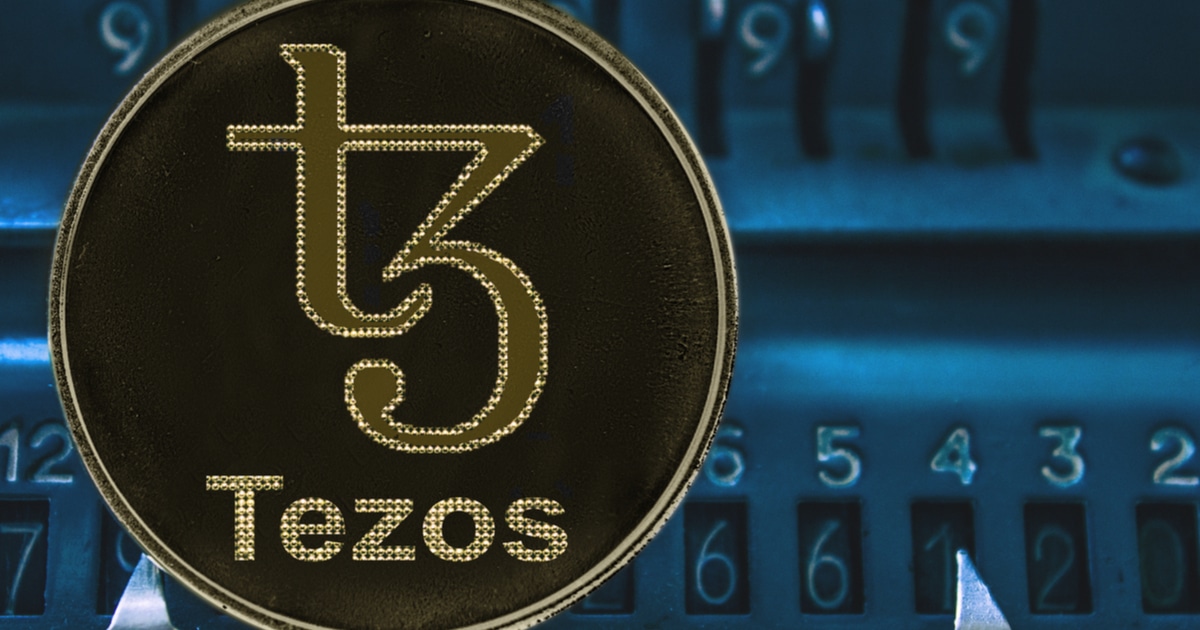Disclaimer: This article is updated all day long. All time codes are in the UTC time zone, updates in reverse order (the latest update is placed at the top).
Paris Blockchain Week Summit (PBWS), a flagship European blockchain conference hosted at Palais Brongniart in Paris, started Wednesday with an all-star cast. Fresh after announcing its French version, Cointelegraph has set up a team for the event to present the latest updates for the event in a real-time fashion.
The first day of the event will see significant names in the crypto and blockchain ecosystem speak about the crucial topics for the ecosystem. The Cointelegraph ground team will present last-minute updates in one easy-to-read article with time codes.
Don’t forget to check this article regularly to get notified about the most recent announcements from the event.
“That's a wrap:” Cointelegraph team will be on the ground again on Thursday for the second day of the event.
Silvio Micali, founder of Algorand, told Cointelegraph: “Competition is always good. We welcome competitors in the sector! The blockchain sector is working hard to solve real-world solutions — join us.”
14:41 — People who want to fraud or launder money won’t use crypto, according to Binance’s Stephanie Cabossioras. They will use other means, mainly cash, “which is still the easiest way to launder money.”
14:26 — How to Leverage Blockchain to Prevent Crime session starts with experts from Binance, Blockchain Intelligence Group, Chainalysis and KeyStone Legal.
14:20 — “No one is looking to Vitalik [Buterin] for any sponsorship [within the Ethereum ecosystem]. Because it doesn’t make sense. Ethereum itself is totally decentralized, you can’t find anybody to change it” — co-founder of Phala Network Marvin Tong
14:00 — Centralized entities like Twitter or Facebook make it very hard for users to make a real change. Elon Musk bought over nine percent of Twitter and even he failed to add the “Edit” button to the platform. The main attraction of Web3 is giving more control to the users, Quanstamp CEO Richard Ma says.
13:55 — Web3 is decentralization and true ownership, according to Sandbox vice president of marketing Rahim Attaba. Web3 is a game-changer for gamers around the world and it allows developers to give back to the community, he argues.
13:50 — Ready Player 3: How Web3 is Powering the Metaverse session starts.
Teodora Atanasova, founding member of Nexo: “NFTs are a very free space and more and more women are entering the space thanks to the opportunities and creativity they provide.”
13:35 — There is a lack of a common language of sorts between regulators and crypto companies, as regulators’ focus is not on regulating the technology but on its interaction with the masses. Crystal Blockchain’s Hedi Navazan says: “On the other hand, innovators are only thinking from a technology perspective.”
13:25 — Meanwhile, over on the Junior Stage, the regulatory framework of cryptocurrencies is the main topic.
13:25 — Talking about whether one should hold their crypto assets or use them on a medium of exchange, Trenchev says:
“Historically, ‘hodling’ has proven beneficiary for many, but at the same time, when we are moving forward in terms of innovation and building several tools with blockchain, crypto assets can be used as a medium of exchange as we move forward.”
13:15 — On the question of lack of regulatory clarity among many developed countries Boaz Avital, head of product at Anchorage, says:
“Innovation is happening really quickly and innovation often gets ahead of the regulations. In the meantime, innovators can set the precedent and do what regulators are there for i.e., protect the investors.”
13:05 — The next session starts with Nexo co-founder Antoni Trenchev introducing the new Nexo crypto card that allows users to pay without selling their Bitcoin.
12:50 — Ring in! Copper.co’s head of Switzerland Marcos Benítez Rubianes substitutes for Michael Milner, kicking the new session by talking about the changing role of custody service providers and the evolution of security infrastructure over the years.
12:45 — Tan explains various ways in which users, as well as decentralized finance (DeFi) protocol developers, can mitigate hack risks. He advocates for educating more people to identify high-risk projects.
12:35 — Lawrence Tan begins his address with an insight into the growing DeFi market which has seen constant growth from the retail as well as an institutional side over the past couple of years. However, security still remains a major concern with billions in losses in 2022 alone.
Tan points toward the four major vulnerabilities namely admin key compromise, coding flaws, rug pull and flash loan attacks, which are often exploited by hackers to steal millions.
12:30 — DeFi Security: The Risks Behind the Yield and Mitigation session takes off with Bybit spot business development director Lawrence Tan.

12:25 — Kalfon says traditional companies are working with more than one blockchain system at a time based on the use cases they are in need of. Interoperability and regulatory clarities are other key factors that impact adoption among traditional firms.
Energy impact is among the top three concerns of traditional companies entering the crypto realm, Kalfon says. “Companies are definitely monitoring carbon footprints of various crypto protocols before integrating or using it.”
12:15 — Kalfon talks about the shift in narrative and focus of conventional companies toward blockchain and Web3 and how it's no longer a “taboo subject.”
She explains that the blockchain investment or integration was limited to certain geeks in the firm back then, but now it has made its way to the executive level and board members.
12:05 — Pauline Adam-Kalfon shares some of the key insights from the company’s latest global survey of over 140 companies comprising blockchain and traditional firms.
“The key takeaway from the survey is that blockchain and crypto assets have become a necessity for businesses,” she says, adding that the question is no longer about for/against crypto and more about when/how.
“In France, more than 60% of the conventional companies that have undertaken blockchain projects are profitable while it’s 20% for the global market.”
12:00 — Lunch time is over: The fireside chat with PwC partner Pauline Adam-Kalfon kicked off.
11:15 — The last session before the lunch concludes. Finally Time for some walk-around videos:
11:10 — Talking about the role of bridges in the current ecosystem and the security vulnerabilities that they have shown over the years, Meere says that currently, bridges are only facilitating messages from one blockchain to another, but in the future, they would facilitate the movement of assets across platforms.
Security has definitely been an issue in the recent past, but it would eventually evolve and developers would learn from the mistakes. The panel then discusses the role of sidechains that would eventually make the ecosystem quite scalable.
The common consensus among panelists is that the EVMs are definitely the starting stage focusing on interoperability, but they cannot become a flag bearer of interoperability in its current form.
11:05 — The next topic of discussion is the role of Ethereum Virtual Machines (EVMs) in making interoperable blockchain networks. Meere says the EVM is still evolving and being developed, but in its current form, it cannot support the larger goal of interoperability, as it only supports one coding language.
10:55 — Ruben Meere from Ngrave says the development process in the crypto space is so rapid that interoperability solutions can’t keep up with the rate of development. James Friel from Axelar believes that technical complexities are another roadblock to interoperability solutions along with the security. He says that “Permission multisig cannot be a long-term solution, and security must come from decentralization.”
10:45 — On the Master Stage, the Interoperability: Challenges and Opportunities session starts.
“Out of the 50 largest hedge funds in the world, 80% are looking at a crypto strategy,” David Olsson, head of institutional distribution at BlockFi, revealed to Cointelegraph.

10:30 — The panelists have varying opinions on custody and security of assets for institutions and what changes in the current custody system would potentially make institutions more comfortable with crypto.
Caujolle says that “Harmonizing will be a key area of focus and product solutions specifically catering to the needs of institutions.”
Fischer calls the current custody market a “cluster fuck” and believes that regulations have a key part to play in order to make it more accessible. He says: “Regulators have to keep up with innovation and allow for self-custody. Unfortunately, regulators are living in the world and lack technical capabilities.”
10:14 — Yoann Coujolle from BPI Finance stresses the need for the bank’s involvement with crypto, as they have the resources to onboard the masses. He said: “Banks need to adapt and get specific tools and processes to drive mass adoption of the cryptocurrencies.”
10:07 — Talking about the interaction between the traditional institutions and the crypto market, David Olsson from BlockFi says that both parties would need to evolve to come to a level playing field. He explained:
“The truth is, a lot of institutional money is flowing into crypto, but the majority of it is not from their own balance sheet. Rather, they are allocating it to 25-30 years old who use that capital on their behalf, but still, there’s a lot of scope in terms of expertise among institutions.”
9:50 — Smart Money Moving in: Institutional Investments in Digital Assets session kicks off with the participation of execs from Bpifrance, Rockaway Blockchain Fund, Woorton and BlockFi.

9:45 — Tejpaul says that the majority of big institutions today are moving into Web3 as it offers better products and brings more value for customers. He concludes his speech with the example of Coinbase, where out of $270 billion worth of assets under their management, 50% belongs to institutions.
9:40 — Tejpaul: “Cryptocurrencies have definitely drawn users to Web3, but the use cases have gone well beyond that for example DeFi, NFTs and DAOs.”
“Web3 is poised to solve many modern problems such as trustworthy ownership, and in coming years, it would be completely interwound with the day-to-day life of common people.”

9:35 — Tejpaul starts his address by offering key differences among the three generations of the web i.e Web1, Web2 and Web3.
While Web1 was all about one-way interaction, Web2 brought a centralized form of two-way interaction between consumers and the service provider, he explains that “Web3, on the other hand, would be a new era of the internet with decentralization at its core where we not only exchange information but values.”
9:31 — Coinbase head of institutional and cloud business Brett Tejpaul is on stage (or, rather, on-call) for the Empowering the Crypto Economy at Scale session.
Between sessions: Cointelegraph asked Alex Mashinsky, CEO of Celsius, about the group’s 6,000 Bitcoin (BTC) payout to clients last year in interest. Mashinsky quickly corrected the Cointelegraph reporter: “Actually it was 6,095 BTC in interest to the Celsius community. The largest payout among lenders.”
9:25 — A Decade in Crypto session with Blockchain.com co-founder Nicolas Cary and Cointelegraph editor-in-chief Kristina Lucrezia Cornèr concludes.
9:11 — The crypto industry is one of the only industries to integrate great renewable measures, Cary adds: “We should encourage more research and the industry has the potential to bring a green evolution using crypto.”
9:05 — Crypto combines many things that everyone doesn’t understand, Cary continues: “However, with a peer-to-peer approach, that hurdle can be overcome. If we work together, we can become stronger.”
9:01 — Talking about the diversity in the crypto community and how it could eventually help the industry grow further, Cary said:
“If you want to see crypto go to the moon, my challenge to everyone in this room is to download a wallet and set up five of your friends with that crypto wallet and send them $5-10 worth of crypto each. If we managed to do that, we will see a 5x increase in the number of users in 12 months.”
8:55 — “In the long run, we are leaning into some fundamental human values such as an open-source system which is quite different from traditional finance. We are building systems based on which anyone can build tools to protect their own wealth.”

8:47 — Talking about the difference between blockchain and crypto events of today and the ones from the early days, Cary says that “the blockchain events have become more acceptable today, while earlier people used to wear face masks to remain anonymous.”
“We are building fabrics of the internet that would allow anyone regardless of their circumstances to trade, exchange, save, earn rewards of different types of digital wealth.”
8:43 — Nicolas Cary talks about the difficulties of running a blockchain company that started in 2011 and how the firm started developing various tools around Bitcoin.
“Our first tool was a Bitcoin wallet which was one of the first noncustodial wallets with over 85 million users across 200 countries.”
8:40 — Blockchain.com co-founder Nicolas Cary and Cointelegraph editor-in-chief Kristina Lucrezia Cornèr takes the stage to talk about a decade in crypto.
8:10 — Decentralized blockchain identity protocol KILT announced web3name. It enables users to create unique names representing their digital identity, which can be linked to addresses on KILT and across the Polkadot ecosystem.

7:30 — Binance CEO’s keynote concludes with the announcement of a new partnership with Station F, a major startup campus in France.
7:29 — CZ says France is very uniquely positioned in terms of regulations, talent and expertise and has the potential to become a leading crypto hub in Europe. “I think France has one of the most progressive and open-minded governments that could help in developing pro-crypto regulations.”
7:25 — Talking about how he manages such a large consortium of crypto platforms, CZ said: “The key secret is they should not do very much.”
Binance’s growth depends on the growth of the ecosystem and “This is why we don’t see other crypto platforms as competitors and rather as their peers.”
7:22 — Binance plans to offer customer support in all 31 languages that it supports in the near future.
7:18 — CZ explains how regulations have evolved over the years and how the approach of regulators has changed significantly.

“We have seen a great shift of attitude toward crypto over the past year until last year, regulators were talking in a negative way while many regulators today approach us with a positive note.”
7:15 — Binance is now available in over 70 countries out of the top 100. Binance Labs, the investment arm of the exchange, has invested more than $100 million in about 100 crypto projects whose combined liquid market cap of $7 billion, seeing a 66x increase in three years.
7:06 — Binance CEO Changpeng ”CZ” Zhao is on the stage. He started his speech with a basic question: “How many of you hold Bitcoin (BTC) or crypto?”

You can get bonuses upto $100 FREE BONUS when you:
💰 Install these recommended apps:
💲 SocialGood - 100% Crypto Back on Everyday Shopping
💲 xPortal - The DeFi For The Next Billion
💲 CryptoTab Browser - Lightweight, fast, and ready to mine!
💰 Register on these recommended exchanges:
🟡 Binance🟡 Bitfinex🟡 Bitmart🟡 Bittrex🟡 Bitget
🟡 CoinEx🟡 Crypto.com🟡 Gate.io🟡 Huobi🟡 Kucoin.



















Comments